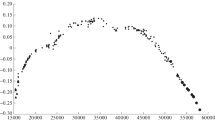Abstract
Orbital-period variations of the low-mass, semi-detached eclipsing binary RT Per are analyzed. In addition to the secular variation of the orbital period determined by the mass transfer between the components, cyclic variations are also present. Both the light-time effect and magnetic oscillations can describe the cyclic orbital-period variations of RT Per. The secular period increase can be explained by a uniform flow of matter from the lower-mass to the higher-mass component at a rate of 0.60 × 10−8M-/year, with the total angular momentum being conserved. The period variations can be represented equally accurately by either a superposition of two cyclic variations or a superposition of a secular period increase and two cyclic variations. Approximately the same parameters are derived for the lower-period (36.8 year) variations when the times of minima are fitted with a linear or a quadratic formula. For the longer-period variation, a period of 275 years and amplitude of 0.104 days are found using the linear formula, or 89 years and 0.045 days using the quadratic formula.
Similar content being viewed by others
References
W. Ceraski, Astron. Nachr. 166, 155 (1904).
R. S. Dugan, Contr. Princeton Univ. Obs., No. 1 (1911).
O. Struve, Astrophys. J. 106, 92 (1947).
Wen-Xian Lu, Acta Astron. Sin. 31, 140 (1990).
M. T. Edalati and F. Zeinali, Astrophys. Space Sci. 243, 275 (1996).
B. B. Sanwal and U. S. Chaubey, Astrophys. Space Sci. 75, 329 (1981).
R. S. Dugan, Mon. Not. R. Astron. Soc. 75, 692 (1915).
R. S. Dugan Contr. Princeton Univ. Obs., No. 17 (1938).
A. A. Vasil’eva, Astron. Tsirk., No. 75 (1948).
P. Ahnert, Mitt. Veränder. Sterne 6, 143 (1974).
H. Frieboes-Conde and T. J. Herczeg, Astron. Astrophys. Suppl. Ser. 12, 1 (1973).
I. Todoran, Inform. Bull. Var. Stars, No. 1687, 1 (1979).
J. B. Rafert, Publ. Astron. Soc. Pacif. 94, 485 (1982).
S. Mancuso, L. Milano, and G. Russo, Astrophys. Space Sci. 47, 277 (1977).
T. Panchatsaram, Astrophys. Space Sci. 77, 179 (1981).
C.-H. Kim, J. Astron. Space Sci. 12, 179 (1995).
S. O. Selam and O. Demircan, Turk. J. Phys. 23, 301 (1999).
S. Qian, Astron. J. 122, 2686 (2001).
B. R. N. O. Project—Eclipsing Binaries Database. http://var2. astro. cz/EN/brno/index. php.
D. Ya. Martynov, in Variable Stars, Ed. by M. S. Zverev, B. V. Kukarkin, D. Ya. Martynov, P. P. Parenago, N. F. Florya, and V. P. Tsesevich (Gostekhizdat, Moscow, 1947), Vol. 3, p. 464 [in Russian].
A. I. Khaliullina and Kh. F. Khaliullin, Sov. Astron. 28, 228 (1984).
J. H. Applegate, Astrophys. J. 385, 621 (1992).
F. Lanza, M. Rodonò, and R. Rosner, Mon. Not. R. Astron. Soc. 296, 893 (1998).
E. Lanza and M. Rodonò, Astron. Astrophys. 349, 887 (1999).
Kh. F. Khaliullin, Sov. Astron. 18, 229 (1974).
I. Iben, and A. V. Tutukov, Astrophys. J. 284, 719 (1984).
A. V. Tutukov, A. V. Fedorova, E. V. Ergma, and L. R. Yungel’son, Sov. Astron. Lett. 11, 52 (1985).
Author information
Authors and Affiliations
Corresponding author
Additional information
Russian Text © A.I. Khaliullina, 2019, published in Astronomicheskii Zhurnal, 2019, Vol. 96, No. 3, pp. 196–204.
Rights and permissions
About this article
Cite this article
Khaliullina, A.I. A Double Wave in the Orbital-period Variations of the Eclipsing Binary RT Per. Astron. Rep. 63, 182–189 (2019). https://doi.org/10.1134/S1063772919030041
Received:
Accepted:
Published:
Issue Date:
DOI: https://doi.org/10.1134/S1063772919030041




